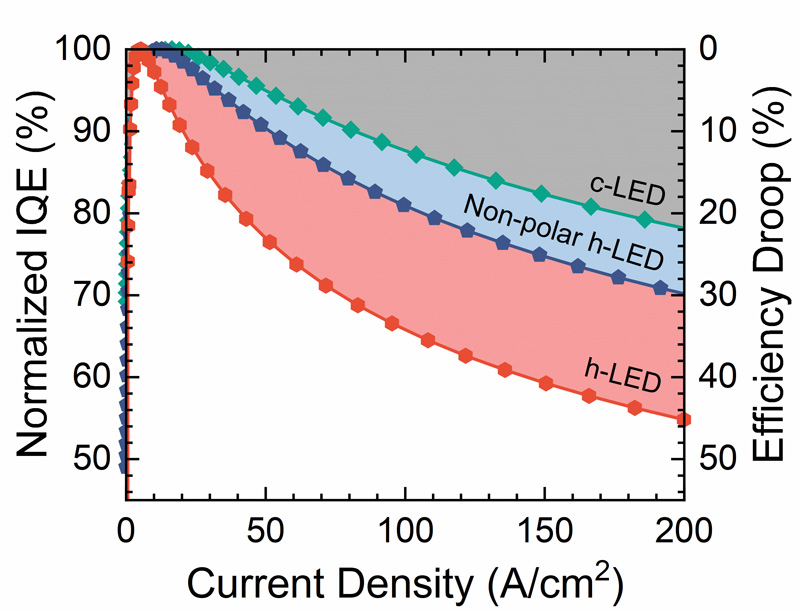News: LEDs
28 April 2022
Efficiency droop halved in cubic- versus hexagonal-phase InGaAlN LEDs
It is widely accepted that the large Auger coefficient is the main cause for the large (~50%) efficiency droop in traditional hexagonal-phase indium gallium aluminium nitride (InGaAlN) LEDs. Yet this explanation is inadequate to account for the low efficiency droop in gallium arsenide (GaAs)- and gallium phosphide (GaP)-based LEDs, as those have similar Auger coefficients.
Now, Can Bayram, Jean-Pierre Leburton and Yi-Chia Tsai at the University of Illinois at Urbana-Champaign (UIUC) have shown that the coexistence of strong internal polarization and large carrier effective mass accounts for about 51% of the efficiency droop under high current densities in hexagonal-phase InGaAlN green LEDs (h-LEDs) compared with cubic-phase InGaAlN green LEDs (cLEDs) – see Y.-C. Tsai, J.P. Leburton, C. Bayram, ‘Quenching of the Efficiency Droop in Cubic Phase InGaAlN Light-Emitting Diodes’, IEEE Trans. Electron Devices (2022); https://doi.org/10.1109/TED.2022.3167645.
Previously, the efficiency droop reduction in non-polar h-LEDs was attributed to the decrease in carrier leakage from the active region, overlooking the interplay between internal polarization and Auger recombination. Indeed, recent experiments suggest that the efficiency droop reduction in non-polar h-LEDs is in fact due to carrier delocalization (a situation different than in polar h-LEDs) that results in stronger electron-hole wavefunction overlap, lower quantum well carrier densities, and lower Auger recombination rates. The UIUC team found out that large carrier effective mass promotes carrier localization and degrades the band-to-band optical transition matrix element.

Picture: Normalized internal quantum efficiency (IQE) (left y-axis) and efficiency droop (right y-axis) as a function of current density. Red hexagons and green rhombuses refer to hexagonal-phase (h-) and cubic-phase (c-) InGaAlN LEDs; blue pentagons refer to nonpolar h-LED grown on m-plane GaN substrates.
According to this new interpretation, the researchers show that switching from polar h-LEDs to c-LEDs quenches the efficiency droop from 45% to 22% (i.e. a 51% reduction) due to polarization elimination and effective mass reduction. It is further found that the quantum efficiency of c-LEDs is much more immune to the Auger electron-hole asymmetry, the increase in Auger coefficient, and thus efficiency degradation mechanisms. Hence, cubic-phase InGaAlN green LEDs offer an appropriate solution for quenching the efficiency droop.
Effect of Auger electron–hole asymmetry on efficiency droop in InGaN QW LEDs









